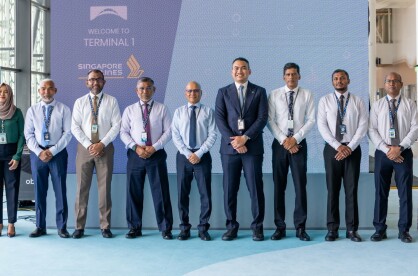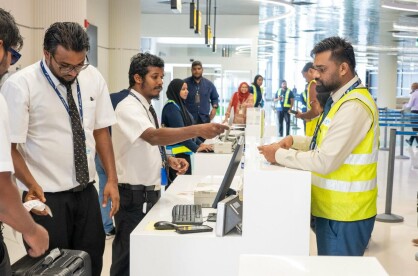The problem with the state fisheries company
More transparency and less political involvement is needed to earn back the trust of fishermen

MFR Images
More transparency and less political involvement is needed to earn back the trust of fishermen

MFR Images
For many fishermen in the Maldives nowadays, the Maldives Industrial Fisheries Company (MIFCO) is seen more as a villain than a hero, one which is depriving them of their hard earned income. On 20 September 2020, when MIFCO announced the abandonment of the fixed price mechanism for skipjack tuna, 7 years after it was first implemented, the anger of many fishermen reached a boiling point, with numerous fishermen going on strike against MIFCO and the government. Some may argue that the recent removal or resignation of the Minister of Fisheries, Marine Resources and Agriculture Zaha Waheed was also part of the government’s strategy to win back some lost support. Many have been left questioning on what needs to be done with MIFCO, and why it cannot be run akin to a private sector company.
Transparency
Given that MIFCO is a state-owned company, the public demands more transparency in its operations, which must be communicated clearly to fishermen and the public. When it axed the price controls, MIFCO confidently said floating prices would reflect global prices and that it would be displayed and updated daily. However, this was only done on face value and lacked any details on how it was calculated.

Data available from the Maldives Monetary Authority (MMA)'s monthly statistics show that MIFCO’s prices do not reflect global prices. After the price controls were removed, the price of skipjack tuna in the Maldives fell from MVR18.0 to MVR14.0 per kg, a decline of 22 percent. However, international prices based on Bangkok frozen market prices between October 2020 to January 2021 showed an increase of 39 percent on average on an annual basis. However, there was a decline when month-on-month prices were compared, with an average decline of 5 percent observed during the same period.
Based on ‘Skipjack tuna, Bangkok prices’ published in Undercurrent News, after reaching $1,400 per metric ton in December 2020, prices have remained around $1,300 per metric ton to date in 2021, though there was a decline in February. As such, even though skipjack prices in the international market had changed, no price changes was made by MIFCO during the last eight months, giving rise to the questions as to how reflect MIFCO's prices are at this point.
Audit and company financials
Since the company was formed in 1993 and although it may have carried out external audits, these were not published. The only report that was published was done by the Auditor General's Office in February 2015 on the negative impacts of splitting the company on an ad hoc basis in April 2010. The report showed that the company, which had been posting sales of MVR900 million and profits of MVR30 million in 2008, was making only MVR155 million in sales and posted a loss of MVR2.1 million in 2012 due to the split. The three fisheries companies combined (MIFCO, Kooddoo and Felivaru) recorded sales of over MVR1 billon and a profit of around MVR18 million in 2012. Separate financial data for MIFCO was not available thereafter until 2016.
In September 2016, when the company’s accumulated debts reached over MVR300 million, the government, perhaps with the intention of making it financially efficient and to achieve synergies, transferred MIFCO under the State Trading Organization (STO), as a subsidiary. Although the current government, then in the opposition, was highly critical of the move, MIFCO is still being run as a subsidiary of STO. Further, given that it is a subsidiary of STO, separate financial statements for the company are not available for an analysis of how profitable, or not, its operations are.
The only data available on MIFCO are summaries of data published in STO’s annual reports. In 2019, STO’s annual report showed that ‘fisheries net revenue’ was MVR1.4 billion. Assuming that 'fisheries net revenue' refers to revenues from MIFCO, this indicates a 4% increase in revenues compared to 2018, as published in the report. It also reported a loss of MVR116 million in 2019. The loss however, was higher in 2018, reported at about MVR200 million. This loss in 2019 was registered despite government grants to the tune of over MVR223 million. Other key performance indicators are not publicly available and hence improvements, or lack thereof, in the operations of MIFCO is left only for speculation.
Political Influence
Each government to date has made various pledges and promises to fishermen, using MIFCO as the main vessel to deliver on these promises. Political involvement and meddling in the operations of the company have led to cash flow issues within the company resulting from mismanagement or inefficient operations. This has in turn, left fishermen not being paid a fair price for their catch. Further, at times when fishermen bring in a good catch, they have been unable to sell their catch given that MIFCO has not, or has not been able to, build up storage capacity to meet increased supplies. Each time the government ends up bailing out the company.
Various governments have made efforts to increase the capacity of MIFCO by injecting investment capital into the company. However, there has been slow or no increase in capacity, leading to public speculation, especially among fishermen, of these funds being misappropriated.
Ismail Fauzee, the current Chief Operating Officer of MIFCO, plans to turn things around, and says there has been improvements. According to Fauzee, MIFCO has increased its purchases by over 50 percent to 22,766 tonnes in April, and had paid over MVR350 million for purchases from fishermen. President Ibrahim Mohamed Solih has also pledged to increase MIFCO's daily fish purchasing capacity by 61 percent in 2021, with additional investments in increasing its cold storage facilities. Whether these pledges and plans come to fruition will decide whether the government can earn back the trust of fishermen.



